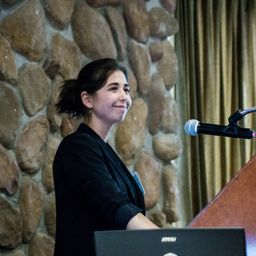Structural conversion of non-toxic amyloids into hypertoxic oligomer-like fibrils
My Session Status
Structural conversion of non-toxic amyloids into hypertoxic oligomer-like fibrils
Phuong Trang Nguyen1,2, Ximena Zottig1,2, Mathew Sebastiao1,2, Alexandre Arnold1,2, Isabelle Marcotte1,2 and Steve Bourgault*1,2
1Department of
Chemistry, Université du Québec à Montréal, Montreal, Canada, H3C 3P8,
2Quebec Network for
Research on Protein Function, Engineering, and Applications, PROTEO, Quebec,
Canada
Proteinmisfolding and tissue deposition of cross-β-sheet amyloid assemblies are linked with numerous diseases. Whereas compelling biochemical evidences have revealed that the cytotoxic proteospecies of the amyloid cascade are the prefibrillar intermediates, toxicity of mature and highly ordered amyloid fibrils has also been shown. Discrepancy regarding the cytotoxicity of oligomers and amyloid fibrils is associated with (supra)structural diversity and polymorphism, complexifying characterization. In the present study, by harnessing the islet amyloid polypeptide (IAPP) whose deposition in the pancreatic islets is associated with type II diabetes, we describe the formation of highly toxic amyloid fibrils with oligomer characteristics. These oligomer-like fibrils are assembled from an IAPP derivative containing an apparently trivial Asn-to-Gln substitution at position 21 (N21Q). N21Q cytotoxic fibrils share (supra)molecular structural properties with non-toxic amyloid fibrils formed with the WT counterpart, including the prototypical4.7 Å inter-strand distance, a β-sheet-rich conformation and recognition by anti-amyloid antibodies. Concurrently, cytotoxic N21Q fibrils have biophysical characteristics of toxic oligomers; low capacity to bind thioflavin-T,high surface hydrophobicity, high flexibility and recognition by the A11 anti-oligomer antibody. These oligomeric characteristics are associated with high ability of the N21Q fibrils to disrupt lipid membranes and to cause cellular dysfunction. Particularly, the toxic oligomer-like conformation of N21Q fibrils, which is preserved upon fibril elongation, is transmissible to naïve WT IAPP. The identification of cytotoxic mature fibrils with prefibrillar characteristics expands the diversity of amyloids andthese stable oligomer-like assemblies represent a unique opportunity to elucidate the structural features mediating amyloid disorders.






Discussion